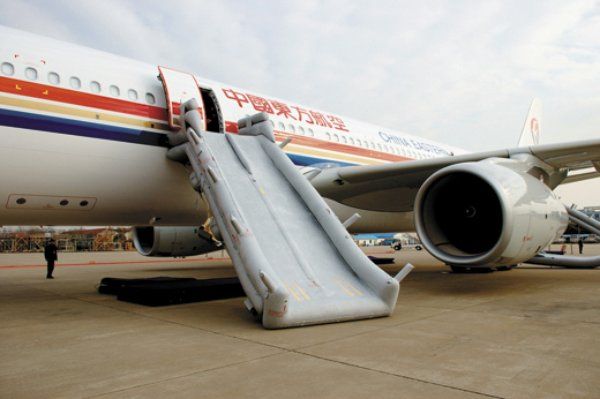How Things Work: Evacuation Slides
De-plane in the fast lane
/https://tf-cmsv2-smithsonianmag-media.s3.amazonaws.com/filer/ef/b9/efb964d9-635b-4fad-9397-d07ff0438f97/htw_388-jun14.jpg)
THE POST-CRASH FIRE THAT CONSUMED Air France Flight 358, an Airbus A340 that overran a Toronto runway in 2005, could have been a killer, but all 309 aboard escaped with no life-threatening injuries. By the time emergency response teams had arrived, 52 seconds after the airliner burst into flames, most of the passengers had already exited on evacuation slides.
The Airbus met almost to the letter the Federal Aviation Administration requirement that an airliner be capable of being evacuated within 90 seconds in the dark and with half the exits blocked—“almost” to the letter because the crash occurred not in the dark but on an August afternoon. But the evacuation was successful even though several exits were compromised by the fire and jagged metal and one slide was inoperable, apparently jarred loose when the airliner plunged into a ravine.
Designing evacuation slides has grown more complex as the FAA has tightened performance standards. In the early 1960s, slides had to deploy in 25 seconds in non-extreme weather: no wind and medium-range temperatures. Today’s slides must deploy in six seconds in temperatures ranging from –65 to 160 degrees Fahrenheit and unfurl in winds up to 25 knots (28.7 mph). Airlines impose further challenges: Slides must be light and compact enough to fit inside an aircraft door or below the door sill or emergency exit window. So each slide is uniquely developed for its location on an aircraft model.
An escape slide sits inside a carbon fiber pressure cap covered by a casing of material similar to the aircraft interior walls—that big square box at the bottom of an airliner’s interior door. Pushing a lever on the interior door—a large silver bar on early airliner models, smaller handles on later ones—arms the slide mechanism by linking the slide to the door sill. When the lever is in the “armed” position, opening the door pulls the slide out of its pack. The slide then drops to the correct orientation for inflation to begin. (When flight attendants issue the call to “cross-check” after landing, that is a signal for one attendant to check another’s action to disarm the doors to prevent slides from inadvertently deploying.)
Slides inflate with an initial boost from a canister of compressed carbon dioxide and nitrogen. The canister provides only about one-third the volume needed to inflate the slides. The remaining volume is supplied by ambient air, channeled into the slides through aspirators.
When the inflation mechanism is triggered—by a lanyard pulled by the slide as it tumbles from its storage case—gas from the canister accelerates through the aspirators at high speed, creating a vacuum that sucks ambient air into the aspirators through louvers. When the slide is fully inflated, the louvers close.
At its Phoenix, Arizona plant, Goodrich manufactures airliner evacuation slides for a number of airliner models, including the 16 slides aboard each giant Airbus A380. To get the A380 slides fully inflated in six seconds, Goodrich developed an inflator that uses a gas generator about the size of a soda can that contributes more inflation gas volume to the slides without adding too much bulk and weight to the slide package. When a propellant in the generator is ignited, it produces a highly compressed gas almost instantly. This gas mixes with stored gas in the canister to accelerate slide inflation.
Slides are made of urethane-coated nylon that is sprayed with gray aluminized paint, which protects the slide in case of a nearby fire by reflecting heat for at least the 90 seconds of the slide’s use. To save pack weight and decrease inflation time for the A380 and new-generation aircraft to follow, Goodrich adopted a stronger fiber for the inflation tube fabric. Increasing the strength and tear resistance of the fabric enables slide inflation tubes to be designed with a smaller diameter.
The inflated slide must flex precisely under a variety of weights to enable passengers to slide down quickly but not so fast that they are injured when they reach the bottom. In order to ensure that 800 passengers could exit an A380 in 90 seconds, its dual-lane slides are qualified to transport 70 passengers in one minute.
Developing modern slides is “like trying to balance a sheet of plywood on the head of a pin by throwing nickels at it from 50 yards away,” says Mark Robertson, a Goodrich vice president for engineering and quality, describing the amount of old-fashioned trial and error necessary. At its Phoenix plant, Goodrich uses an environmental chamber, six giant wind machines, elevated aircraft test fixtures including actual aircraft doors, and darkened tunnels connected to the doors for test jumps onto slides in simulated rain and nighttime conditions. For a standard dual-lane slide, test subjects make as many as 50 test runs at various pressures and door sill heights.
According to Goodrich, the reason passengers sustain injuries during evacuation is that they ignore instructions and hesitate or stop at the end of the slide, making them collide with other evacuees coming down, or instead of sitting upright, they lie down and descend too fast. Targets on the slide and built-in light-emitting diode (LED) lights give evacuating passengers aim points for jumping on and off.
Because slides must often function as life rafts for as many as 87 people, Goodrich conducts trials off the coast of Santa Barbara, California, where ocean conditions closely approximate those set forth in FAA regulations for exit slide performance.
With proper maintenance, a slide will last 15 years. Every three years a slide is deployed, removed, inspected, re-tested, re-packed, and re-installed. The inspection cycle is a way to make sure that slides will perform as they did last August, when a China Airlines 737 arriving in Okinawa experienced an engine explosion, and all 165 aboard escaped safely on inflatable slides just before the plane burst into flames.
